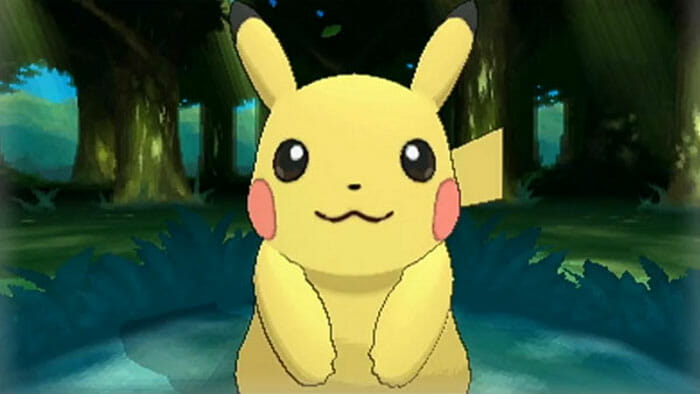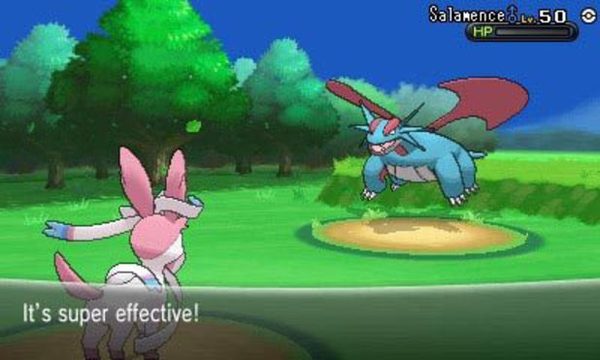Pokemon X and Y (3DS)

Pokémon X and Y (from here on called, collectively, X & Y) feel astounding simply by feeling like modern games. It’s weird to hold something up and say, “this is exceptional by virtue of meeting the standards set by its peers,” but the Pokémon series spent 15 years burying its huge, amazing world under the weight of barely animated graphics and a story progression that requires patience and effort to even start. That was the deal: Nintendo and Game Freak would provide the world, and I would do the heavy lifting required to play in it. Finally, with Pokémon X & Y, Nintendo has decided to give me a break and share the load.
From the beginning, Pokémon X & Y shows you how much it’s changed. Earlier games just ask you if you’re a boy or a girl, but X & Y asks for your skin tone as well; you’re going to be able to customize your appearance even more as the game goes on. Instead of fading in from black and seeing your character wake up, X & Y starts more dynamically by spinning the camera around your bedroom to follow a well-animated and rendered pokémon. The world is big, three-dimensionaland filled with beautiful-looking creatures. Earlier games had you plodding slowly from house to house until you found “running shoes” which allowed you to jog; in X & Y, the second you push the analog stick, your tiny trainer moves full tilt. What are you waiting for? Nintendo’s not stopping you.
With each new mechanic smoothed over and each traditional stepping stone from the old games chipped away, a part of me began to worry that Game Freak would accidentally end up ruining Pokémon. Many games, in their attempts to reach a wider audience, end up flattened and appealing to no one. So much more impressive, then, that X & Y never lets that happen.
Pokémon X & Y even goes so far as to make it easier to level your pokémon up: capturing pokémon gives your team experience points, and a new and improved “Exp Share” item shares those points with your whole roster, so there’s no more time spent wandering the fields grinding to get ready for the next Gym. This “easy button” may sound like it sucks all the challenge away from the game, but what it really does is get out of the way of letting the player explore the world, which is what I wanted most from Pokémon X & Y.
Exploring in Pokémon X & Y feels different than in most other adventure games. Instead of the stark loneliness of Metroid or the pioneering “Manifest Destiny” of Minecraft, Pokémon X & Y feels like backpacking during a semester abroad, with stops along the way to turn over rocks and look for salamanders. Your very linear journey takes you through the Kalos region of Pokémon World.
Inspired by France, Kalos is full of palaces, cafes and pastoral country-sides, each brimming with new pokémon to encounter. The series has up to 718 different pokémon at this point. Of those, only about a hundred can’t be found in X & Y, meaning there are six hundred different pokémon in this game. Every time I entered a region, I was sure to see a new creature, which feels extra exciting given that seeing any new pokémon includes a chance to catch it and make it my friend.
In fact, Pokémon X & Y gives you a whole new way to make your adorable captives your friends. One of the three modes taking up the 3DS’ bottom screen is “Pokémon Amie”, a Nintendogs-like chance for you to rub your pokémon’s belly, feed it snacks and play some rudimentary games with it, all to earn its love. While totally optional, “Pokemon Amie” has benefits beyond just how cute it is to watch a Chespin eat a cupcake: Mmaking a pokémon your friend also grants in-game bonuses. Pokémon who love you get extra health, and fight harder for you. Hits that would otherwise knock them out reduce a well-loved pokémon to one hit point instead; in the world of the game, they stay in the fight out of pure devotion to you.
The second mode is “Super Training,” where you help your pokémon work a heavy punching bag, turning them all into tiny Rocky Balboas (which I’m tempted to name all my Rock-type pokémon). This screen lets you boost the base stats of each of your pokémon, training them to round out their weaknesses or continue to enhance their strengths into a one-sided powerhouse. All of these stats were in the series’ earlier games, but they were hidden from players until Pokémon X & Y. Stats buffing was something for serious trainers only, and “Super Training” breaks down one of the barriers to becoming a real pokémon master.
The third and final feature that takes up the touch screen is the most surprising, especially for a Nintendo game: “The Player Search System”, or PPS, which includes an incredibly robust set of online features. Pokémon X & Y uses the PPS to make it easy for you to connect with your friends, or to find strangers to battle or to trade pokémon with. The “Global Trade System” portion of the PPS acts like pokémon online personals, allowing you to list which pokémon you want to get rid of and which you’d like in return. Then there’s “Wonder Trade,” which pairs up pokémon trainers who want to live on the edge; each participant sends out a pokémon to trade without knowing what they’ll get in return. It’s a digital lottery ticket, and while I’ve gotten my fair share of Metapods and Zoobats, legends of other players getting Shiny Dittos keep me coming back.
Not content to simply refine its formula, Pokémon X & Y also adds a few changes to the series’ core gameplay. A new Fairy Type of pokémon means everyone needs to re-learn which type is super-effective against what, and helps take the edge off against the once-unbalanced Dragon Type pokémon. Mega-Evolutions are also new to the series, which allow your pokémon to temporarily Hulk out during battle, changing shape and getting stronger until the effect wears off. I’m sure the kids will love it, but since there’s no downside to Mega-Evolutions in the single player campaign, it doesn’t feel interesting strategically. It’s possible there’s a deeper use for this new feature in battles against other players, but I wasn’t able to find it.
